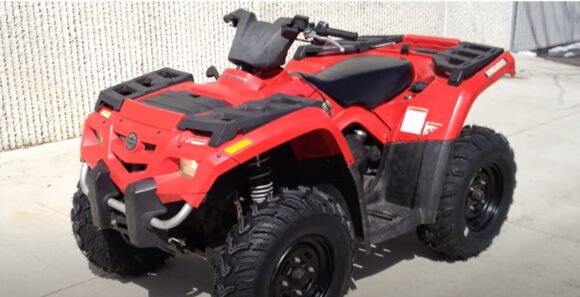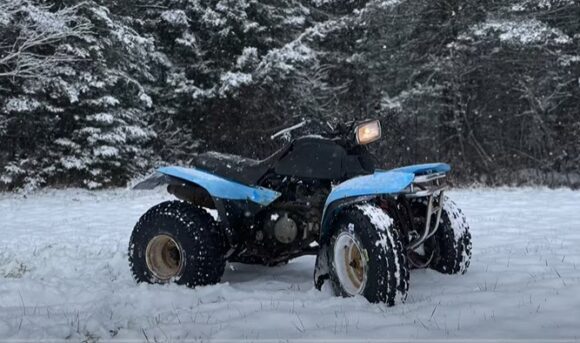The 2004 Bombardier Outlander is a popular all-terrain vehicle (ATV) that is designed to provide riders with a smooth, comfortable ride. However, like any vehicle, it is prone to problems and malfunctions, especially as it ages
The most common 2004 Bombardier Outlander 400 problems include:
- Starting problem
- Fuel system problem
- Charging problem
- Transmission problem
- Fan runs constantly
2004 Bombardier Outlander 400 Problems
If you own a 2004 Bombardier Outlander 400 and are having issues, keep reading to learn the likely causes and potential solutions.

1. Starting problem
If your 2004 Bombardier Outlander 400 won’t start, a dead battery is the most common reason an Outlander 400 won’t start. Fuel issues including blocked fuel filters or poor fuel are also common.
The spark plug may be a problem if the battery and fuel systems operate properly. Clogged or unclean carburetors restrict fuel from reaching the engine.
The Outlander 400’s ignition switch, coil, or other components may be defective.
The fix
- Make sure there is sufficient petrol in the tank. Add more gasoline if necessary if the level is low.
- Use a clean and correctly gapped spark plug. Replace it if it’s soiled or worn.
- Clean the carburetor yourself or have a professional do it.
- Check for wear or damage on the starter motor and starter solenoid if the starter motor won’t turn over. If required, swap them out.
- Low compression might make it difficult for the engine to start. Replace any broken components after using a compression tester to check the compression.
If these remedies don’t work, you may need to take your Outlander 400 to a mechanic.
Many of these issues can be avoided with regular maintenance and inspection.
2. Fuel system problem
Fuel system problem with the 2004 Outlander 400 is another concern. Dirt and debris can accumulate in the fuel filter over time, resulting in its clogging.
This can restrict fuel passage and negatively impact engine performance.
The carburetor can become soiled over time, particularly if the Outlander is driven in muddy or filthy environments.
A filthy carburetor can result in poor fuel economy, difficult engine starting, and other performance issues.
Leaks in the fuel system can cause fuel to escape, resulting in diminished engine performance and potentially hazardous circumstances.
Fuel that is stale or contaminated can reduce engine performance and even cause damage to the fuel system components.
The fix
- Check the fuel filter for debris and, if necessary, replace it.
- Connect a fuel pressure gauge to the fuel line and start the engine to inspect the fuel pump. If the fuel pressure is minimal or nonexistent, it may be necessary to replace the fuel pump.
- Replace any fuel lines that are damaged or clogged with debris.
- Use a carburetor cleaner or take the carburetor to a mechanic for a professional cleansing.
- It is possible that the spark plug is fouled or worn, preventing the engine from starting or operating properly. Examine the spark plug for damage or deterioration, and if necessary, replace it.
3. Charging problem
A defective battery can cause charging issues since it may not be able to hold a charge. The voltage regulator controls the amount of electricity delivered to the battery by the alternator.
A defective voltage regulator can cause charging issues.
While the engine is running, the alternator is in charge of charging the battery.
If the alternator fails, the battery will not charge properly, and the alternator will have to be replaced.
Loose or corroded connections also cause charging issues by preventing the battery from obtaining the required charge.
The fix
- First, verify the battery’s charge and condition. A voltmeter should show 12.6 volts for the battery. Charge a low-voltage battery.
- Alternators charge the Outlander. Check the alternator’s operation. Measure the alternator voltage with a voltmeter. The engine running voltage should be 14 volts. If the alternator doesn’t charge, replace it.
- Check the alternator-to-battery wiring for damage. Find loose connections, frayed wires, and corrosion. Wiring faults may limit battery charging.
- The regulator/rectifier can also malfunction. This gadget adjusts alternator voltage and converts AC to DC power. It won’t charge if it’s broken. Check regulator/rectifier voltage with a voltmeter. If it’s broken, replace it.
- Check charging system fuses for blowouts. Blown fuses prevent battery charging.
4. Transmission Problem
Over time, the transmission fluid may become soiled or contaminated with debris, causing it to lose its efficacy.
In addition, transmission components may not receive sufficient lubrication from transmission fluid that has become degraded.
Malfunctioned transmission solenoid can cause the gearbox to shift inadequately or not at all.
The transmission may slide or not engage properly if the clutch is worn or damaged.
Mechanical damage to the transmission, such as fractured gears or worn bearings, is also possible.
The fix
- Clear red fluid is ideal. If it’s dark and smells burnt, the transmission may be overheated or damaged. In this situation, a mechanic must diagnose it.
- Check for fluid leaks around the transmission, such as puddles or a moist underside. eaks can cause low fluid levels and damage the transmission over time.
- The transmission mount secures the transmission to the vehicle chassis. Driving with a worn or damaged one can damage the transmission as well.
- Transmission and gear selector are linked by the shift linkage. It can prevent the gearbox from shifting if it’s loose or damaged.
5. Fan runs constantly
The fan may run constantly if the fan switch is stuck in the “on” position. The fan’s wiring may be broken or shorted.
The engine’s coolant temperature sensor controls the fan’s on/off cycle.
The fan may operate continuously if the sensor is broken. For a defective fan motor, the fan may run constantly.
The fix
- Disconnect the temperature sensor to test the thermostat. Probably the thermostat.
- Check fan wiring for loose connections or damage. Damaged wiring might make the fan operate continuously. Fix or replace damaged wiring.
- The thermostat turns the fan on and off based on temperature. If it’s broken or misreading, the fan may run endlessly. Multimeters or mechanics can test the sensor.
- Check the motor for damage and wear. Check the motor’s power and operation with a multimeter.
- Inspect the radiator for dirt and damage. If problems arise, clean or replace the radiator.
How Good is the 2004 Bombardier Outlander 400?
Off-roaders love the Outlander 400’s powerful engine and rapid acceleration. Even on tough terrain, the Outlander 400 has a comfortable seat and smooth suspension. The Outlander 400 is another bombardier vehicle. Maintaining this ATV can extend its lifespan.
Rocks, logs, and other obstacles don’t bother the Outlander 400’s high-ground clearance. The Outlander 400 is flexible for hunting, fishing, farming, and ranching.
However, Outlander 400 is a heavy ATV, making it harder to maneuver in small situations or steep hills. The Outlander 400 is complex and expensive to fix.
Riders may find the Outlander 400 engine loud. Fueling the Outlander 400 is expensive because to its poor fuel economy. Riders that carry a lot of gear may find the Outlander 400 lacking in storage.
Overall, the 2004 Bombardier Outlander seems to be a reliable and durable ATV that provides good power and a comfortable ride. However, as with any vehicle, it’s important to keep up with regular maintenance to prevent issues from arising.
Arctic Cat Prowler 650 Problems


